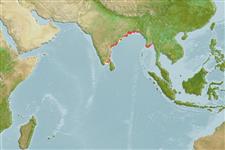Environment: milieu / climate zone / depth range / distribution range
Ecologie
marien; zoet water; brak water; amfidroom (Ref. 51243); diepte 0 - 50 m (Ref. 189). Tropical; 26°N - 7°N, 76°E - 99°E (Ref. 189)
Indian Ocean: eastern coasts and estuaries of India, and also Irrawaddy River at Rangoon, Myanmar. All Indian references to a species with over 7 pectoral filaments must apply to Coilia reynaldi.
Grootte / Gewicht / Leeftijd
Maturity: Lm ? range ? - ? cm
Max length : 15.0 cm TL mannelijk / geslacht onbekend; (Ref. 189)
Korte beschrijving
Morfologie | Morfometrie
Dorsale stekels (totaal): 0; Anale stekels 0; Anale zachte stralen: 80. Body tapering, belly rounded before pelvic fins, with 6 to 9 + 7 to 11 = 13 to 19 keeled scutes from just behind pectoral fin base to anus. Maxilla short, not reaching to edge of gill cover. Pectoral fin with 10 to 13 long filaments; the branched fin rays much shorter those of pelvic fin.
Occurs in coastal and tidal stretches of rivers, but apparently no data on salinity tolerances. Its presence above Barrackpore on the Hooghly in India suggests that it can live in freshwater. Larvae feed on copepods; thereafter mainly on copepods, but also on prawns, larval decapods and other crustaceans. Breeds in the lower parts of estuaries. The time and duration of the breeding season reported vary for different estuaries in India.
Levenscyclus en paargedrag
Maturiteit | Voortplanting | Paaien | Eieren | Fecunditeit | Larven
Breeds in lower parts of estuaries (Ref. 189). Spawn in school (Ref. 205).
Whitehead, P.J.P., G.J. Nelson and T. Wongratana, 1988. FAO Species Catalogue. Vol. 7. Clupeoid fishes of the world (Suborder Clupeoidei). An annotated and illustrated catalogue of the herrings, sardines, pilchards, sprats, shads, anchovies and wolf-herrings. FAO Fish. Synop. 125(7/2):305-579. Rome: FAO. (Ref. 189)
Status op de Rode Lijst van het IUCN (Ref. 130435)
Gevaar voor de mens
Harmless
Gebruik door de mens
Visserij: van minder commercieel belang
Meer informatie
Leeftijd/GrootteGroeiLengte-gewichtLengte-lengteLengtefrequentiesMorfometrieMorfologieLarvenLarvale populatiedynamiekRekruteringAbundantieBRUVS
ReferentiesAquacultuurAquacultuurprofielKweeklijnenGeneticaElectrophoresesErfelijkheidZiektesVerwerkingNutrientsMassaconversie
Tools
Speciale rapporten
Download XML
Internetbronnen
Estimates based on models
Preferred temperature (Ref.
123201): 27.9 - 28.9, mean 28.4 °C (based on 48 cells).
Fylogenetische diversiteitsindex (Ref.
82804): PD
50 = 0.5001 [Uniqueness, from 0.5 = low to 2.0 = high].
Bayesian length-weight: a=0.00282 (0.00124 - 0.00641), b=3.10 (2.92 - 3.28), in cm total length, based on LWR estimates for this Genus-body shape (Ref.
93245).
Trofisch niveau (Ref.
69278): 3.3 ±0.46 se; based on food items.
Generation time: 1.6 ( na - na) years. Estimated as median ln(3)/K based on 1
growth studies.
Weerstandsvermogen (Ref.
120179): Hoog, minimale populatieverdubbelingstijd minder dan 15 maanden (K=0.7).
Fishing Vulnerability (Ref.
59153): Low vulnerability (20 of 100).
